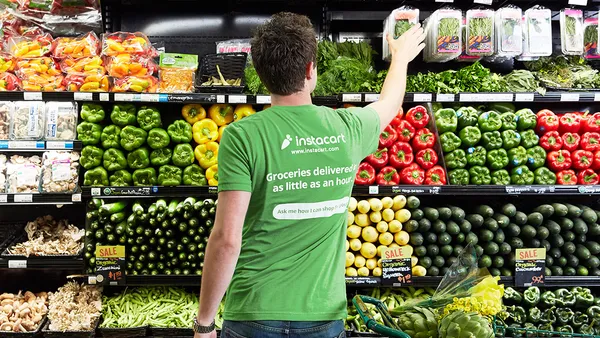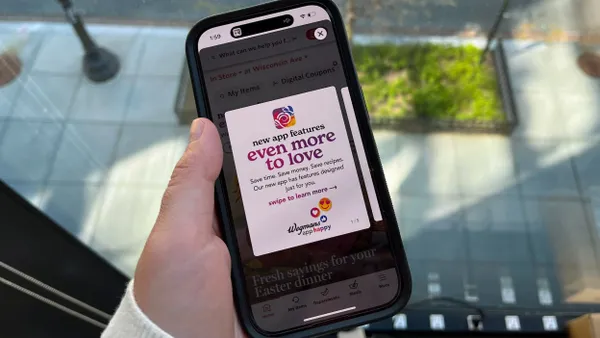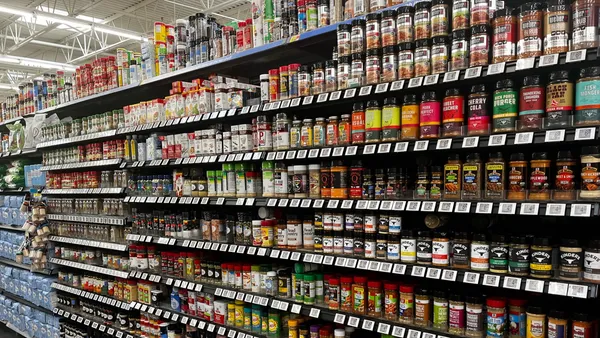Disruption breeds innovation, and after a year that saw plenty of both, experts say grocers will continue to evolve the shopping experience while also trying to enhance their core strengths. From digital developments to a new age of store remodels, it's anything but business as usual in food retailing.
-
Grocers will take mobile amenities to the next level
Retailers and service partners like Instacart have made mobile shopping widely available. But as consumers become more accustomed to using their smartphones across all aspects of their lives, they’ll expect to have helpful shopping tools in stores, too.
Jason Goldberg, chief commerce strategy officer with Publicis, a digital consulting firm, believes retailers will make more product information available through their apps while also offering personalized deals.
“All of these supplemental attributes that used to be hard to find in a grocery store are super easy to find on a website,” Goldberg told Grocery Dive. “Increasingly, retailers will make that information available to customers with some tool that they can use when they’re at home, out and about or in-store.”
Many retailers offer QR codes and list-building tools, but with Amazon and Walmart pouring money into digital enhancements, Goldberg expects grocers to advance to the next level. Kroger, for instance, has begun installing digital shelf panels that interact with shoppers’ phones. The chain also recently introduced a health app called OptUp that tracks the nutritional quality of shoppers’ purchases and recommends healthier options.
According to eMarketer, last year 18 million U.S. consumer used a grocery app at least once a month — a 49.6% increase over 2017. This year, the firm predicts 22.6 million will use grocery apps at least once a month, rising to more than 30 million by 2022.
Goldberg expects Albertsons to make big moves this year. In May, the retailer announced it will pilot Amazon Go like technology that utilizes mobile devices in its stores and last year the retailer upgraded its mobile app to better facilitate online orders.
How else could mobile capabilities evolve? Goldberg sees potential for augmented reality to play a bigger role in grocery stores as the technology develops.
“I think grocery is one of the places augmented reality has a practical application like holding your phone up to the produce section and having the phone overlay the produce with supplemental information on your screen,” said Goldberg. “I think that’s a useful shopping amenity we’ll see this year.”
“Increasingly retailers will make that information available to customers with some tool that they can use when they’re at home, out and about or in-store.”

Jason Goldberg
Chief commerce strategy officer, Publicis
-
Creative partnerships will evolve
Last year saw numerous tie-ups that crossed channels and industries. Kroger put mini grocery departments inside Walgreens stores. Aldi tacked a few locations onto Kohl’s department stores. Hy-Vee took a big bite out of the restaurant business by opening Wahlburgers locations. And meal kits from top brands like Blue Apron and HelloFresh infiltrated grocery store shelves.
What’s behind all these eye-catching partnerships? Natan Reddy, senior analyst with CB Insights, pointed to a few factors — namely, evolving consumer preferences around convenience and Amazon’s growing presence in grocery. As industry competition heats up, grocers are trying to be more things to more people, and to reach shoppers in new places.
“You’re seeing a lot of traditional brick-and-mortar retailers finding these new ways to drive foot traffic to their stores,” Reddy told Grocery Dive.
Reddy expects this trend of strange bedfellows joining forces to continue — both through strategic partnerships and acquisitions. It’s a phenomenon that’s happening across retail, he said, with companies like Kohl’s, which accepts Amazon returns, seeing increased foot traffic as a result.
Could Walmart buy a major meal kit brand? Could Kroger's private brands eventually show up in WeWork spaces? In this environment, anything seems possible.
"The old ways of driving awareness and foot traffic are not working for retailers," Reddy said.
Kroger -
Delivery will become the priority for retailers
After Amazon bought Whole Foods in 2017, retailers rushed to build out click-and-collect services, which were a quick and relatively inexpensive way to offer online shopping. However, experts believe delivery will be e-grocery’s competitive frontier, with new innovations and service providers rushing onto the scene.
In addition to Instacart and Shipt, last-mile specialists like Deliv, DoorDash and Postmates have moved into grocery. Reports note that Uber is also planning an entry. Meanwhile, Amazon and Walmart are expanding their delivery footprint while automated fulfillment solutions promise to boost efficiency and lower prices for customers.
“I don’t see people loving pickup. They’re just doing pickup,” Ran Peled, head of marketing for CommonSense Robotics, which develops small, automated warehouses that fulfill grocery orders, recently told Grocery Dive. CommonSense’s internal research, he said, shows that if price and quality are equal, 80% of consumers prefer delivery to store pickup.
Late last year, Instacart quietly slashed its fees, a nod to the growing competition for delivery fulfillment as well as emphasis on price. Daphne Carmeli, CEO Deliv, which recently secured $40 million in new funding, says grocers want to own more of the data and customer experience themselves.
“I believe history repeats itself and that in 2019 we’ll start to see that more retailers are going to pivot to own the customer rather than join the marketplace,” Carmeli told Grocery Dive. “They want to own the transaction. They want to own the data.”
“I believe history repeats itself and that in 2019 we’ll start to see that more retailers are going to pivot to own the customer rather than join the marketplace. They want to own the transaction. They want to own the data.”

Daphne Carmeli
CEO, Deliv
With same-day delivery becoming table stakes for grocers in competitive markets, Carmeli expects there to be more piloting, testing and learning around autonomous delivery. Walmart along with Kroger are both testing driverless delivery in Arizona — an innovation that promises to cost less for grocers over the long run while bringing down fees for consumers.
“Now that gives Amazon a run for their money,” Carmeli added.
-
Stores will transform
Can wood smokers and beer kiosks save the supermarket?
Stop & Shop certainly hopes so. With shoppers eating more of their meals away from home and at the same time demanding greater quality and convenience, the northeastern chain added eye-catching features to 21 stores in and around Hartford, Connecticut. The plan is to roll out those features that resonate to more stores as part of a company refresh.
“We recognize that our consumers are changing, and that means we need to change as well,” Mark McGowan, Stop & Shop’s president told Grocery Dive in a recent interview.
Stop & ShopStop & Shop is far from the only retailer remaking its stores. Cub Foods is remodeling locations to include popcorn machines and a burrito bar, while Hy-Vee has added in-store restaurants and service counters to many of its stores. Aldi, the discount chain that’s operated in the U.S. since 1976, hopes fresh-focused store updates and new builds will help become the third largest retailer in the country, behind Kroger and Walmart.
A lot of store updates have focused on enhanced fresh offering. Experts say this will continue, but they also point to improvements in personalization and technology.
A big driver of grocery store transformation, said Vicki Eickelberg, senior vice president and managing director with brand experience firm Big Red Rooster, is the transformation happening across retail channels. With companies like Indochino offering individual appointments, and others like Blush Beauty emphasizing expert staffers, the bar for what a shopping experience should be continues to rise.
“Your shoppers are not just benchmarking their experiences in your store with other stores, they’re benchmarking across their entire shopping pattern,” Eickelberg said during a recent industry presentation.
-
Private label will move into new categories
In 2018, private label growth soared with grocers pushing out premium private label options in addition to value brands. In fact, private label sales continue to outpace the national brands with dollar sales growing 5.8% from 1.5% over the past year, according to research firm IRI.
This momentum will continue to grow throughout 2019, according to Diana Sheehan, vice president of retail and shopper insights with Kantar Consulting. Sheehan attributes this ongoing evolution of private label to retailers' focus on quality and variety as they fight to stand out from the competition and eke out higher margins. Private label will also enter new sectors that are gaining popularity among consumers, she said.
“I think private label will launch into categories where it hasn’t always been in and I think that’ll be one to watch as you move in to 2019,” said Sheehan.
Those categories are places where shoppers may have not been historically interested in private label brand offers like organic and specialty snacks, she explains. Shoppers may be more open to trying new products now that they’ve built up a brand trust with the retailer.
Sheehan expects the private label space to adapt a Western European retail landscape like Lidl and Aldi, which have disrupted retailers across the globe with their store brand centric assortment.
“I think we are very much in that critical growth spurt in private brands where it’ll continue to grow share,” said Sheehan. “I would anticipate ongoing growth in 2019 and I think we’ll see private label level off more at 20-25% share of total sales in the next 5 years.”
Other retailers who have previously deprioritized private label will continue to invest in their offerings, she added. She also believes retailers will branch off of their purely value-based private label line to more create premium offerings creating a tiered system that casts a wider net for shoppers.
“I would anticipate ongoing growth in 2019 and I think we’ll see private label level off more at 20 to 25% share of total sales in the next 5 years.”

Diana Sheehan
Vice president of retail and shopper insights, Kantar Consulting
-
Regional M&A will heat up
The supermarket industry has seen its fair share of mega mergers in recent years, from Ahold linking up with Delhaize to Amazon buying Whole Foods. But as the pressure to lower prices, improve the store experience and invest in e-commerce grows, regional chains — the hardest hit by these competitive pressures — are lining up in the crosshairs of major retailers.
“Many regional supermarkets are being increasingly pressured by various macroeconomic, microeconomic and corporate finance factors that drive a scale imperative, in one of the largest and most fragmented U.S. retail sectors,” Scott Moses, managing director and head of the food and restaurant investment banking practice with PJ Solomon, told Grocery Dive.
In the past three months alone, discount chain Lidl acquired 27 Best Market stores in New York and New Jersey, SpartanNash acquired Martin’s Super Markets and its 24 locations and Stop & Shop announced plans to acquire King Kullen. Moses, who advised retailers involved in the first two deals and advised Supervalu on its sale of 19 Shop 'n Save locations to Schnucks last fall, said his firm has increased hiring to accommodate the growing mergers and acquisition advisory work it expects to see across the country.
One of the biggest factors driving deals both large and small is Amazon, which has a diversity of businesses, scale and investment capital that no grocer can match.
“Amazon is building an ecosystem that is radically transforming retail forever,” Moses said. “Its very low cost of capital and extremely high equity valuation give it a near limitless ability to invest in transformational competition for food & drug retailers, in a culture that does not fear failure.














